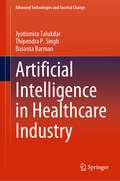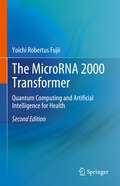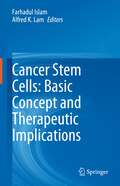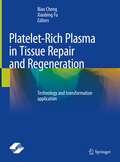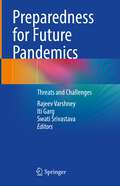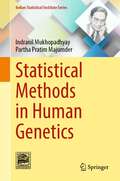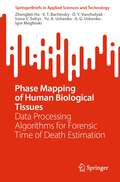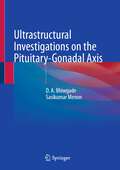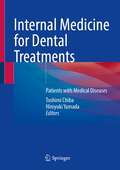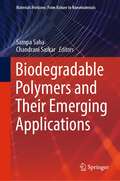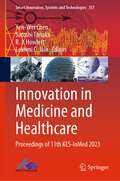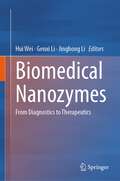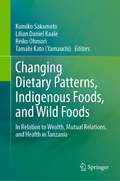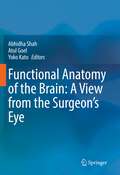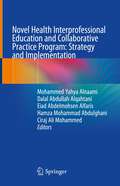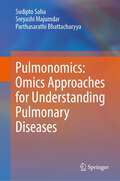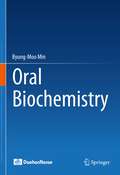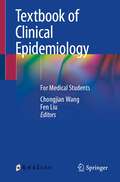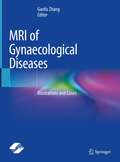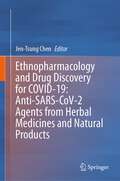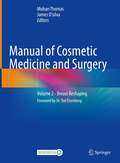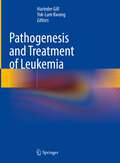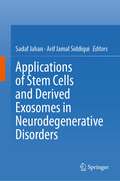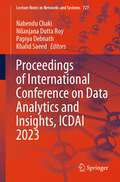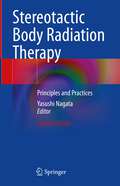- Table View
- List View
Artificial Intelligence in Healthcare Industry (Advanced Technologies and Societal Change)
by Jyotismita Talukdar Thipendra P. Singh Basanta BarmanThis book presents a systematic evolution of artificial intelligence (AI), its applications, challenges and solutions in the field of healthcare. The book mainly covers the foundations and various methods of learning in artificial intelligence with its application in healthcare industry. This book provides a comprehensive introduction to data analysis using AI as a tool in the generation, normalization and analysis of healthcare data in association with several evaluation techniques and accuracy measurements. The book is divided into three major sections describing the basic foundations of AI and its associated algorithms, history of artificial intelligence in healthcare, recent developments and several modeling techniques for the same. The last section of the book provides insights into several implementations and methods of evaluation and accuracy prediction for healthcare analysis in AI. Extensive use of data for analysis and prediction using several technologies has transformed the lives of normal people indirectly effecting our process to communicate, learn, work and socialize within the society. Thus, the book also provides an insight into the ethics of AI that is very vital in the process of implementation and evaluation of healthcare data. The book provides an organized analysis to a considerable part of data in a digitized society. In view of this, it covers the theory, methodology, perfection and verification of empirical work for health-related data processing. Particular attention is devoted to in-depth experiments and applications.
The MicroRNA 2000 Transformer: Quantum Computing and Artificial Intelligence for Health
by Yoichi Robertus FujiiThe second edition includes new findings that were only a theory in the first edition, clarifying what is beginning to be proven true. All chapters have been updated, and new data on the analysis of major depressive disorder from exosome microRNA (miRNA) in plasma, traumatic brain injury, and Alzheimer's disease, brain glioma from cerebrospinal fluid miRNA, liver cancer, induced pluripotent stem (iPS) cell tumorigenesis, and other topics have been added. As predicted in the first edition, diseases can be predicted using the miRNA memory package (MMP) and miRNA entangling target sorting (METS), which could clarify the etiology of human diseases. Because researchers are investigating the relationship between circulating miRNAs and human diseases to develop new medicines, miRNA deep sequencing and detection methods will be high-speed and clever. The microRNA 2000 Transformer - Quantum Computing and Artificial Intelligence for Health is aimed at intermediate and advanced scientists, clinicians, students, and science enthusiasts. The Author hopes to lay the groundwork for future human health innovation.
Cancer Stem Cells: Basic Concept and Therapeutic Implications
by Farhadul Islam Alfred K. LamThis book comprehensively reviews the role of cancer stem cells (CSCs) in cancer initiation, progression, and resistance to anticancer therapies. The initial chapters examine the methods and procedure of the detection, isolation, and characterization of CSCs. It also introduces various epigenetic pathways that contribute to cancer initiation and tumorigenesis, particularly regarding the maintenance and survival of CSCs. It also explores the role of CSCs metabolism and the mechanisms of metabolic plasticity of CSCs in cancer biology. Further, it also presents the implications of CSCs on the origin of tumor heterogeneity and on heterogeneity of the therapeutic response. Towards the end, this book highlights the different immunotherapeutic approaches targeting CSCs with the potential of strongly improving cancer outcomes. This book offers a broad framework to scientists and clinicians into the state-of-the-art knowledge on cancer stem cell biology and highlights their therapeutic implications.
Platelet-Rich Plasma in Tissue Repair and Regeneration: Technology and transformation application
by Biao Cheng Xiaobing FuFrom clinical application to experimental research, this book summarizes the transformation value of Platelet-Rich Plasma, explores its potential research hotspots, and ultimately serves the clinic. On the one hand, the main content of this work is to explain the research progress of Platelet-Rich Plasma in the laboratory, including the mechanisms involved in its research and possible potential therapeutic effects. On the other hand, this work aims to clarify its application foundation and value in Aesthetic Surgery. The purpose is to provide reliable reference tools for relevant work practitioners, build a bridge between experimental research and clinical application, and promote the progress of Platelet-Rich Plasma-related translational medicine.
Preparedness for Future Pandemics: Threats and Challenges
by Rajeev Varshney Iti Garg Swati SrivastavaThe book covers all aspects of future preparedness for COVID-19 pandemic-like situations as the COVID-19 pandemic commences at its endemic stage. Pandemics and large-scale outbreaks impact public health to a greater extent, causing the loss of millions of lives and financial loss to businesses which eventually lead to unemployment and economic crises. This book covers all lessons learned from past pandemics, including their spread, virulence, long-term health effects, etc. It includes a chapter focusing on the actions that need to be taken to deal with similar situations in the future.The book mainly comprehends on identification and fulfilment of gaps in pandemic preparedness, the development of an effective early warning system, the strengthening of existing strategies as well as the need for the implementation of new global policies to mitigate future pandemics. It focuses on the role of omics approaches to understand and explore the newer and faster mechanisms for prevention, detection, and response to emerging biological infections. It also covers the psychological impact due to pandemic and its solution.The book has a broad scientific impact and shall be helpful specifically for academicians/ students having an interest in microbiology, virology, and immunology fields. It is aligned with SDG 3, "Good Health and Well-being".
Statistical Methods in Human Genetics (Indian Statistical Institute Series)
by Indranil Mukhopadhyay Partha Pratim MajumderThis book provides an overview of statistical concepts and basic methodology for the study of genetics of human traits and diseases. It attempts to provide a step-by-step description of problem identification, study design, methodology of data collection, data exploration, data summarization and visualization, and more advanced analytical methods for inferring genetic underpinnings of human phenotypes. The book provides codes in R programming language for implementation of most of the statistical methods described, which will enable practitioners to perform analysis of data on their own, without having to mold the data to fit the requirements of commercial statistical packages. Useful to anyone engaged in studies to understand and manage good health, the book is a useful guide for sustainable development of humankind. Primarily intended for practicing biologists especially those who carry out quantitative biological research, in particular, human geneticists, the book is also helpful in classroom teaching.
Phase Mapping of Human Biological Tissues: Data Processing Algorithms for Forensic Time of Death Estimation (SpringerBriefs in Applied Sciences and Technology)
by Zhengbin Hu V. T. Bachinsky O. Y. Vanchulyak Iryna V. Soltys Yu. A. Ushenko A. G. Ushenko Igor MeglinskiThis book presents numerical computer-aided smart-methods as part of a comprehensive statistical, correlation and fractal analysis of laser polarimetry data. It highlights relationships between polarization (azimuth distributions, polarization ellipticities, Stokes vector parameters, Mueller matrix elements) parameters of laser images of biological tissues of a human corpse in different spectral ranges and temporal dynamics of their postmortem morphological changes. The book discusses the effectiveness of correlation analysis of two-dimensional distributions of polarization inhomogeneous images of histological sections of the main types of biological tissues in determining the time of death. It also discusses the development of basic principles of phase measurements (phasometry) of microscopic images of biological tissues to determine the age of death and the time of hematoma formation. Also presented in the book are possibilities of complex laser spectral photopolarimetry images of histological sections of biological tissues of human corpse in different spectral regions, with the simultaneous development and substantiation of a set of statistical and correlational criteria for objective determination of the time of death.
Ultrastructural Investigations on the Pituitary-Gonadal Axis
by D. A. Bhiwgade Sasikumar MenonThis book provides the ultrastructural study of the pituitary–gonadal axis through the electron microscope. It is a compilation of extensive work carried out by Dr. D.A. Bhiwgade and his researchers over the last four decades. It explains the ultrastructural characteristics of pituitary cells in different morphological states and provides a comprehensive approach to identifying the structural and functional distinctions between various pituitary cell types. The book includes ultrastructural evaluations of the testis and epididymis after different experimental interventions to study the physiological correlations of the organs with spermatogenesis and the consequent structural deformities in sperm. An extensive section of different types of placentae is added for understanding the varied interactions of fetal and maternal tissues in the placental barrier. Placental types seen in bats, shrews, rodents, and monkeys are explained at the ultrastructural level to distinguish the tissue interrelationships within different placental layers. Detailed sketches have been provided to illustrate the correlations between the maternal and fetal tissues in different placental types for better understanding. This book is a ready reckoner and offers guidance to researchers and clinicians in understanding the cellular architecture and intracellular changes associated with various physiological states and clinical conditions of the pituitary, testis, epididymis, and placenta. This book offers assistance to all those using electron microscopy to evaluate cellular and tissue systems.
Internal Medicine for Dental Treatments: Patients with Medical Diseases
by Toshimi Chiba Hiroyuki YamadaThis book illustrates the precautions for dental treatment with patients with medical diseases and presents the correlation and relationship between oral symptoms and systemic diseases. It is organized into two parts; the first part is symptomatology presenting the description of some symptoms as general remarks. Then comes the part explaining the diseases, which describe the associations between each medical disease and the oral conditions. Chapters provide intraoral figures and in-depth information to help readers understand the symptoms, mechanisms, and responses, the comorbidities, and medications. As the number of patients with lifestyle-related diseases and metabolic syndrome is in increases, it is important to understand the perioperative oral care for patients with malignant diseases. Internal Medicine for Dental Treatments - Patients with Medical Diseases is a valuable resource not only for undergraduate and post-graduate dental students but also for dental residents, practitioners, and dental nurses. Written by both internal medicine doctors and dentists, this book is a comprehensive guide and easy read for readers at all levels.
Biodegradable Polymers and Their Emerging Applications (Materials Horizons: From Nature to Nanomaterials)
by Sampa Saha Chandrani SarkarBio-degradable polymers are rapidly emerging as a sustainable alternative to traditional petroleum-based plastics and polymers. However, the synthesis and processing of such polymers present unique challenges and opportunities. In this comprehensive volume, Dr. Saha and her team provide an in-depth exploration of the synthesis and processing of bio-degradable polymers and their emerging applications in various sectors from drug delivery to food packaging. Covering a wide range of topics, including synthesis, modification, processing techniques, and few of their advanced applications in emerging areas, this book provides a comprehensive overview of the field. The authors also delve into cutting-edge research on the synthesis, properties and applications of bio-degradable polymers in various fields, such as agricultural, food preservation, biomedical arena, energy storage and other advanced application areas. This volume is an essential resource for scientists, engineers, and policymakers interested in the future of sustainable materials. Whether you are a researcher looking to expand your knowledge of biodegradable polymer synthesis and processing or a policymaker interested in the potential of biodegradable polymers to reduce our reliance on fossil fuels, this book is an invaluable guide to the field.
Innovation in Medicine and Healthcare: Proceedings of 11th KES-InMed 2023 (Smart Innovation, Systems and Technologies #357)
by Yen-Wei Chen Satoshi Tanaka R. J. Howlett Lakhmi C. JainThis book presents the proceedings of the KES International Conferences on Innovation in Medicine and Healthcare (KES-InMed-23), held in Rome, Italy, on June 14–16, 2023. Covering a number of key areas, including digital IT architecture in healthcare; advanced ICT for medicine and healthcare; biomedical engineering, trends, research and technologies; and healthcare support systems, this book is a valuable resource for researchers, managers, industrialists and anyone wishing to gain an overview of the latest research in these fields.
Biomedical Nanozymes: From Diagnostics to Therapeutics
by Hui Wei Genxi Li Jinghong LiThis book aims to summarize the latest research progress of biomedical nanozymes in diagnostic and therapeutic related fields. In terms of diagnostics, it will cover in vitro diagnostics, live analysis, and some emerging bioanalysis. In terms of therapeutics, it will introduce antioxidant therapy, peroxidation therapy and emerging therapy respectively. Furthermore, the research results previously scattered in many journals and conferences worldwide are methodically edited and presented in a unified form. Based on the new ideas and developments presented in this book, it will be of interest to readers from different areas, such as chemistry, materials, nanoscience and nanotechnology, biomedical and clinical studies, etc.
Changing Dietary Patterns, Indigenous Foods, and Wild Foods: In Relation to Wealth, Mutual Relations, and Health in Tanzania
by Kumiko Sakamoto Lilian Daniel Kaale Reiko Ohmori Tamahi KatoThis book presents different dietary patterns, some utilizing wild foods and others facing drastically changing dietary patterns, and shows their implications for health in terms of wealth, mutual assistance, food sufficiency and food diversity. The book examines these globally important issues through a case study of Tanzania. Using a novel methodology based on a global standard quality of life indicator, the book sheds light on the relationship between wild food intake and health in Tanzania. Descriptive case studies illustrate the impact of various food patterns and wild food intake on human health. It also highlights the divergence between food production sufficiency and food diversity. It then discusses the influence of wealth, mutual relations, and methods of food access. Finally, the book concludes with recommendations for maintaining good health in various environments. The intended readers of this book are academics and professionals in the fields of development, nutrition, and environment in East Africa. These include, but are not limited to, regional and district personnel who are actively engaged in development, relevant ministries of food and agriculture, and international organizations such as FAO, UNICEF, UNDP, and UNEP. In the academic field, students and researchers in international studies, development studies, African studies, social studies, cultural studies, nutrition, agriculture, and environmental studies are targeted.
Functional Anatomy of the Brain: A View from the Surgeon’s Eye
by Abhidha Shah Atul Goel Yoko KatoThis book essentially provides a refreshing description of the cortical and subcortical anatomy of the brain and how it relates to function. It includes subtleties of anatomy, advances in imaging, operative nuances, techniques, and a brief discussion about artificial intelligence.It discusses surgical strategies on intrinsic brain tumors in general and gliomas in particular with several images. The issues that need to be considered in decision-making are explained in this book. The best surgical options are described step-by-step. The relevant anatomy and function of the region are discussed and show the consequences of the damage.This book covers the intra-operative nuances to prevent neurological morbidity. Modern imaging features that help during surgery and decision-making are elaborated. The book is heavily illustrated with anatomical images, intraoperative images, radiologic images, and drawings supported by videos of the surgical approaches and techniques.The chapter structure involves reoccurring headings, didactic elements such as chapter summaries, boxes (note, caution), bullet points, tables, flowcharts, key points. This book is handy for neurosurgeons, especially neuro-oncologists, which helps keep them abreast with the advances in the field.
Novel Health Interprofessional Education and Collaborative Practice Program: Strategy and Implementation
by Mohammed Yahya Alnaami Dalal Abdullah Alqahtani Eiad Abdelmohsen Alfaris Hamza Mohammad Abdulghani Ciraj Ali MohammedThis book describes a novel health interprofessional education and collaborative practice (IPECP) program established at King Saud University (KSU), Riyadh, Kingdom of Saudi Arabia. The book has three main sections. The first section introduces interprofessional education's background, theory, and context for collaborative practice. This section elaborates on defining and developing centers of excellence in IPECP, defining and exploring the meaning of interprofessional collaborative practice in contemporary health care, theories of the team working relevant to health and social care systems, and learning in and about interprofessional groups and broader collaboration. The second section explains how to formulate and implement strategies for effective IPECP. It involves developing and implementing a novel health IPECP curriculum, governance, IPECP's impact and implications on health care outcomes, IPE accreditation standards, regulatory policies, and legal structures. The third section describes the result of a case study of an IPECP program established at KSU. This program is developed by the vice-rectorship for health specialties at KSU (VRHS-KSU) in collaboration with partners harvard medical international (PHMI) to enhance health professional education further through interprofessional education and collaboration. For that purpose, a strategic plan is developed to develop learning, teaching, and assessment in all health sciences colleges (HSCs), along with a governance structure to establish a joint "center of excellence in interprofessional education and collaborative practice (CoE-IPECP)". The strategic plan and design of the program summarized in this book were accomplished through several meetings, workshops, and courses conducted at KSU in Riyadh, and harvard macy institute (HMI) in Boston, USA. The toolkit for successful program implementation includes a pro forma business plan, implementation groups' training, matching needs with feasibility, and expected impact on HSCs. Initiation of pilot projects started with implementing some interprofessional courses, establishing an initial physical and IT infrastructure of the center, developing the webpage, newsletter, and listservs, and improving faculty development programs to enhance IPECP at HSCs. Also, this book is a helpful road map for other national and international universities and institutes aiming to develop their professional health education, particularly interprofessional education and collaborative practice.
Pulmonomics: Omics Approaches for Understanding Pulmonary Diseases
by Sudipto Saha Sreyashi Majumdar Parthasarathi BhattacharyyaThis book comprehensively reviews various omics approaches like genomics, proteomics, transcriptomics, and metabolomics for understanding pulmonary disease at molecular and systems levels. The initial chapters present the pathogenesis of major pulmonary diseases, namely, obstructive diseases, restrictive diseases, vascular diseases, infectious diseases, and neoplastic carcinoma. The book chapters provide current information about the role of the microbiome and applications of medical imaging, bioinformatics tools, and databases for diagnosis and designing treatment strategies against complex lung diseases. Further, the book discusses omics technologies to identify biomarkers for the early diagnosis and prognosis of pulmonary diseases. Finally, the book elucidates the multi-omics approaches and data integration using mathematical modeling for insights into the disease etiology towards improving the prognostics and predictive accuracy of disease phenotypes.
Oral Biochemistry
by Byung-Moo MinThis book provides the reader with a comprehensive understanding of oral biochemistry by explaining the role of basic biochemistry and dentistry concepts and identifying their metabolic processes of soft tissues that comprise oral and maxillofacial anatomy. The book also discusses how metabolic abnormalities are related to the development of oral diseases. Readers will gain a comprehensive perspective on a variety of oral conditions and related metabolic abnormalities. Individual chapters are focused on crucial topics such as enamel, dentine, saliva, fluoride, and many more. The importance of evidence-based explanation and case study details are also highlighted. Oral biochemistry is the first book to be devoted entirely to this area, and it will be of interest to researchers, students, and practitioners.
Textbook of Clinical Epidemiology: For Medical Students
by Chongjian Wang Fen LiuThis book is a comprehensive and practical introduction of clinical epidemiology for students and practitioners. It covers both the basic principles and concepts of clinical epidemiology as well as its applications in various medical disciplines.It covers how to design, conduct, and interpret clinical studies using methods such as bias analysis, confounding control, causality assessment, diagnosis evaluation, prognosis prediction treatment comparison, and meta-analysis in this book. It also introduces how to apply these skills to real-world scenarios through case studies and examples that provide a fresh perspective on familiar topics. This book is a useful textbook for graduate and undergraduate students in medical schools, including MBBS (Bachelor of Medicine and Bachelor of Surgery) student.
MRI of Gynaecological Diseases: Illustrations and Cases
by Guofu ZhangThis book systematically covers MRI imaging findings of a spectrum of gynaecological diseases, including ovarian cysts, uterine fibroids, cervical cancer, and endometrial cancer, etc. All chapters are arranged in the same format: simply clinical history is firstly presented in order to help readers mimic the real clinical scenario, and then untypical features in many common diseases and typical features in many uncommon diseases are interpreted. In the end of each chapter, tips in differential diagnosis were summarized by analysing a class of cases with similar imaging performance. All cases in the book have the detailed pathological results, and the pathological specimens are also shown in some cases. It will be an ideal reference for physicians involved in the diagnosis and treatment of gynaecological diseases.
Ethnopharmacology and Drug Discovery for COVID-19: Anti-SARS-CoV-2 Agents from Herbal Medicines and Natural Products
by Jen-Tsung ChenThis book presents a complete overview of COVID-19 and provides a series of in-depth analyses of the literature and a comprehensive discussion and perspectives on promising anti-SARS-CoV-2 agents based on the system of ethnopharmacology, which covers Chinese medicine, traditional medicines of India and Africa, Turkish folk medicine, essential oils, and some well-known medicinal plants. In this book, the current status of therapeutic strategies against COVID-19 was summarized and a perspective of potential options for the future was proposed. Based on ethnopharmacology, some well-established traditional herbal formulations and bioactive compounds with anti-virus activity were repurposed for managing COVID-19 and post-illness, including neurological disorders and kidney illness. Using drug discovery tools, promising immune enhancers were explored from phytochemicals against SARS-CoV-2. Nutraceuticals from dietary plants, spices, and fruits with anti-virus and antioxidant activities were recommended to prevent infection or severe illness caused by emerging variants. With the aid of systems pharmacology, researchers have gained insights into possible molecular mechanisms of anti-SARS-CoV-2 activity and have predicted a range of candidate compounds from medicinal plants to combat COVID-19. This book explores the current knowledge of drug discovery and ethnopharmacology for managing coronavirus diseases. The content proved the anti-SARS-CoV-2 activity from natural products and traditional herbal medicines. It contributes to the management of global public health and fits the goal of establishing “Good Health and Well-Being,” which is one of “The Sustainable Development Goals (SDGs) 2030".
Manual of Cosmetic Medicine and Surgery: Volume 2 - Breast Reshaping
by Mohan Thomas James D‘silvaThis comprehensive plastic surgery manual on breast reshaping explains in detail the various surgical procedures carried out towards increasing the aesthetic appearance of the breast. Today the surgical management of the breast crosses the lines of gender. Male breast or gynaecomastia is an equally vexing problem for the young as well as the old alike. This volume discusses the surgical management of this aesthetic nightmare in a step by step manner with photographs, illustrations, schematics and short videos. This book comprehensively covers the four major conditions requiring surgical breast reshaping. The first being a small breast, requiring solutions including fat grafting or a US FDA approved cohesive silicone gel implant. Needless to say this is a very gratifying procedure providing immediate results with little or no downtime. This volume also covers important topics such as breast reduction in young and older patients which are a very challenging operation for most surgeons’ particularly recent graduates. This volume also deals with the complexities of this procedure taking into account all the factors that will help the reader have a successful outcome. It contains important chapters on the situation of post pregnancy when the women experience the ‘post-partum blues’ secondary to dysmorphic changes to the body, particularly the Breast and its management. Additionally it also explains the commonly encountered complications, pitfalls and useful recommendations stemming from experienced authors. This Manual in Cosmetic Medicine and Surgery sets the standard for Doctors entering the field of aesthetic medicine and surgery. It is a reference book for people who are in practice as well as a step by step manual for students and young doctors wanting to pursue this field. Other five volumes are on: • Nose procedures• Genital procedures • Non Invasive procedures• Cosmetic procedures of the face• Body Contouring surgeries
Pathogenesis and Treatment of Leukemia
by Harinder Gill Yok-Lam KwongThis book covers a comprehensive update on acute and chronic leukemia. In 54 chapters, authors introduce research progress and clinical trials of acute myeloid leukaemia (AML), acute promyelocytic leukaemia (APL), acute lymphoblastic leukaemia (ALL), myelodysplastic syndrome (MDS), myeloproliferative neoplasm (MPN) and chronic myeloid leukemia (CML). The last decade has seen the integration of genetic and clinical information to determine the prognosis and treatment strategies. This book provides practitioners, researchers and graduate students of Hematology and Hematopathology a comprehensive update on the pathobiology, genomics, classification, diagnosis, monitoring, prognostication and therapy of both acute and chronic leukemias.
Applications of Stem Cells and derived Exosomes in Neurodegenerative Disorders
by Sadaf Jahan Arif Jamal SiddiquiThis book explores the therapeutic approaches of stem cells and stem cell-derived exosomes against neurodegenerative disorders (NDDs). The initial chapters introduce different neurodegenerative diseases and discuss the mechanistic aspects of their progression. The subsequent chapters cover strategies for the isolation, characterization, and differentiation of stem cells. In turn, the book reviews the protective role of stem cells against neurological disorders and examines regenerative approaches to treat neurological diseases using mesenchymal stem cells. The book also presents induced pluripotent stem cell (iPSC) technology for cellular therapy, drug screening, and in-vitro modeling of neurodegenerative diseases. Lastly, the book discusses the role of stem cells and derived exosomes as a novel therapeutic agent against Alzheimer's and Parkinson's disease and in associated signaling molecules involved in neuroprotection. This book is an invaluable source for researchers working towards understanding the potential of stem cell therapy in neurodegenerative disorders.
Proceedings of International Conference on Data Analytics and Insights, ICDAI 2023 (Lecture Notes in Networks and Systems #727)
by Khalid Saeed Nabendu Chaki Nilanjana Dutta Roy Papiya DebnathThe book is a collection of peer-reviewed best selected research papers presented at the International Conference on Data Analytics and Insights (ICDAI 2023), organized by Techno International, Kolkata, India, during May 11–13, 2023. The book covers important topics like sensor and network data analytics and insights; big data analytics and insights; biological and biomedical data analysis and insights; optimization techniques, time series analysis and forecasting; power and energy systems data analytics and insights; civil and environmental data analytics and insights; and industry and applications.
Stereotactic Body Radiation Therapy: Principles and Practices
by Yasushi NagataThe second edition of the well-received book updates the knowledge of clinical treatment, radiobiology, physics, and instrumentations to provide a comprehensive description of stereotactic body radiation therapy (SBRT). Clinical aspects include indications and prescriptions for diseases treated with SBRT and clinical trial details. The chapters associated with physics cover quality assurance, patient immobilization devices, respiratory motion management, and treatment planning. It also illustrates the latest devices and provides know-how for safe and reliable treatment that differs from conventionally fractionated radiotherapy. In this second edition, the future of SBRT using artificial intelligence in the post-COVID-19 world also discussed. Stereotactic Body Radiation Therapy 2nd Edition - Principles and Practices enrich the readers' understanding of patient-friendly cancer care. Radiation oncologists, medical physicists, medical dosimetrists, radiation therapists, senior nurses, medical oncologists, and surgical oncologists interested in radiotherapy will benefit from this practical guide. Since the last edition, there has been significant progress in the field, and the book renews the facts and evidence based on cutting-edge research.
